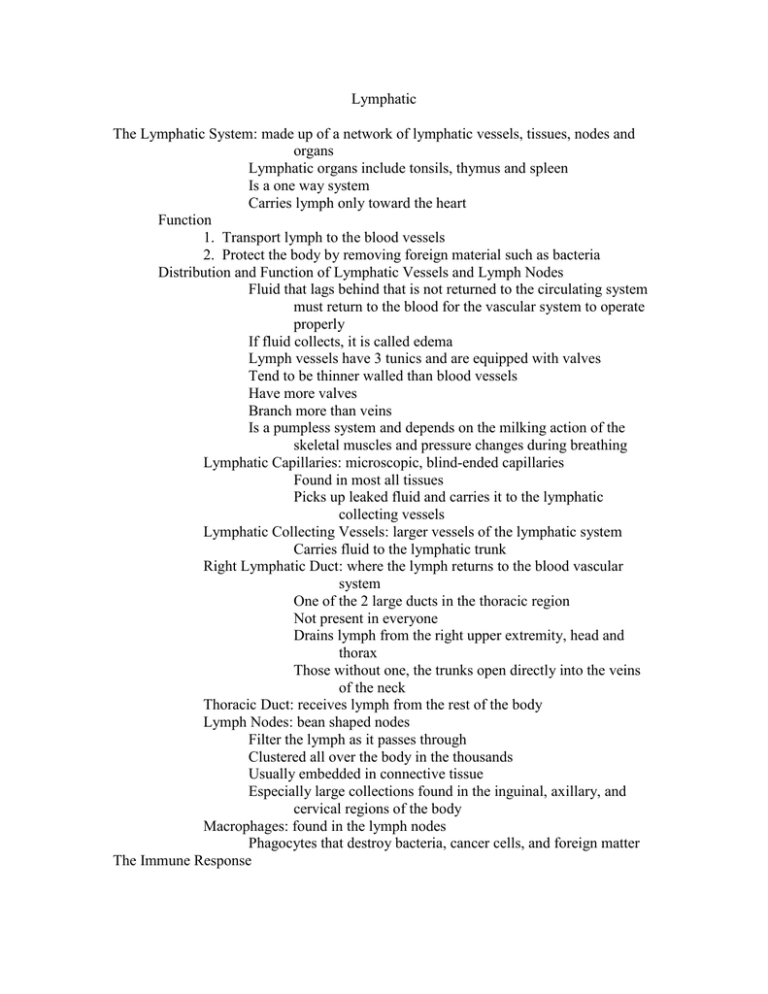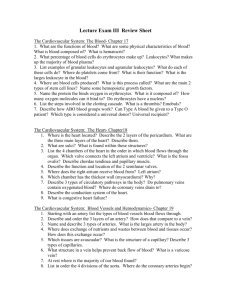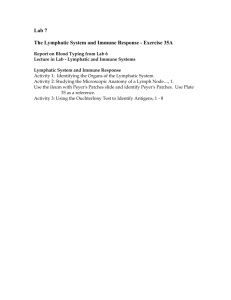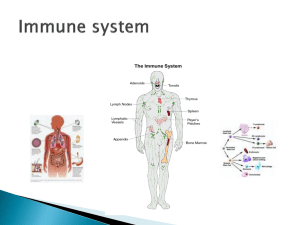Lymphatic The Lymphatic System: made up of a network of lymphatic... organs
advertisement

Lymphatic The Lymphatic System: made up of a network of lymphatic vessels, tissues, nodes and organs Lymphatic organs include tonsils, thymus and spleen Is a one way system Carries lymph only toward the heart Function 1. Transport lymph to the blood vessels 2. Protect the body by removing foreign material such as bacteria Distribution and Function of Lymphatic Vessels and Lymph Nodes Fluid that lags behind that is not returned to the circulating system must return to the blood for the vascular system to operate properly If fluid collects, it is called edema Lymph vessels have 3 tunics and are equipped with valves Tend to be thinner walled than blood vessels Have more valves Branch more than veins Is a pumpless system and depends on the milking action of the skeletal muscles and pressure changes during breathing Lymphatic Capillaries: microscopic, blind-ended capillaries Found in most all tissues Picks up leaked fluid and carries it to the lymphatic collecting vessels Lymphatic Collecting Vessels: larger vessels of the lymphatic system Carries fluid to the lymphatic trunk Right Lymphatic Duct: where the lymph returns to the blood vascular system One of the 2 large ducts in the thoracic region Not present in everyone Drains lymph from the right upper extremity, head and thorax Those without one, the trunks open directly into the veins of the neck Thoracic Duct: receives lymph from the rest of the body Lymph Nodes: bean shaped nodes Filter the lymph as it passes through Clustered all over the body in the thousands Usually embedded in connective tissue Especially large collections found in the inguinal, axillary, and cervical regions of the body Macrophages: found in the lymph nodes Phagocytes that destroy bacteria, cancer cells, and foreign matter The Immune Response Adaptive Immune System: a functional system that recognizes something as foreign and destroys or neutralizes it Immune Reponse: the response of the immune system Is a systemic response and not restricted to the initial infection site Major Characteristics of the Immune Response 1. Memory: for previously encountered foreign antigens 2. Specificity: how specific the memory is 3. Ability to Differentiate Self from Nonself Each lymphocyte is monospecific and will only bind with one or few antigens Our own proteins are tolerated unless the system loses the ability to recognize itself Will attack self Called autoimmune diseases Example: MS, myasthenia gravis, Graves disease, glomerulonephritis, rheumatoid arthritis, insulin dependent diabetes mellitus Organs, Cells, and Cell Interactions of the Immune Response Lymphoid Organs: thymus, lymph nodes, spleen, tonsils, appendix, and bone marrow Thymus and bone marrow are primary lymphoid organs Others are secondary lymphoid organs The stem cells that make the immune system arise in the bone marrow While in the organs, the immune cells become immunocompetent indicated by the appearance of specific cell-surface proteins and allow them to bind to a particular antigen B Cells: differentiate in the bone marrow T Cells: differentiate in the thymus Clonal Selection: occurs after the B and T cells enter the bloodstream Is triggered when an antigen bonds to the cell-surface receptors Causes the cells to multiply rapidly, forming clones of the cell Some of the cells differentiate to form specialty cells (memory cells) Memory B Cells: B cells that retain memory of past antigen contact Plasma Cells: produce antibodies Humoral Immunity: indirect immunity through antibodies made by B cells Cellular Immunity: direct immunity be direct contact with specialized T cells Types of T cells: Cytotoxic T cells: attack Helper T cells: activate B and cytotoxic T cells Suppressor cells: inhibit immune response Antibodies and Tests for Their Presence Antibodies or Immunoglobulins (Igs) Produced by sensitized B cells and plasma cells 5 major classes: IgM, IgA, IgD, IgG, IgE Classes share a common structure but differ in function and localization in the body Composed of one or more monomers (4 protein chains bound together by disulfide bridges) Gamma Globulins: general class of plasma proteins Heavy Chains Light Chains Antigen-binding site: end of the arm of the monomer specifically for binding to the antigen Ouchterlony Double-Gel Diffusion, An Immunological Technique Developed in 1948 to detect the presence of particular antigens






